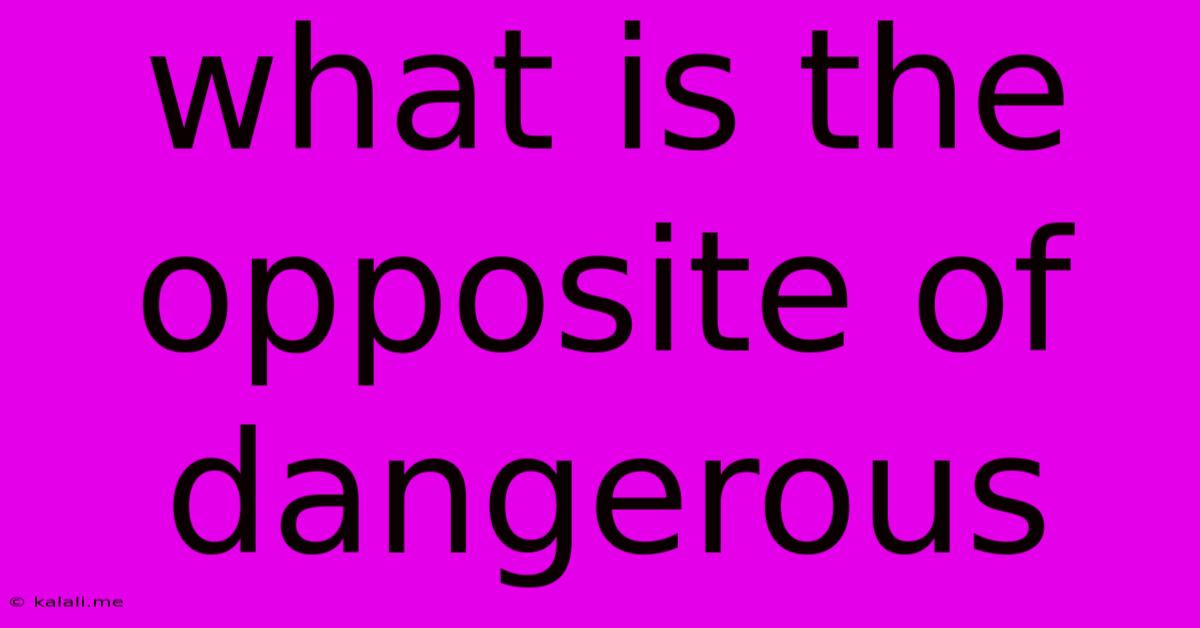What Is The Opposite Of Dangerous
Kalali
Jun 15, 2025 · 2 min read

Table of Contents
What is the Opposite of Dangerous? Exploring Antonyms and Nuances
The seemingly simple question, "What is the opposite of dangerous?" reveals a fascinating complexity in language. While a straightforward answer might seem obvious, delving deeper reveals a nuanced landscape of antonyms depending on the context. This article explores various antonyms for dangerous and the subtle differences in their meaning. Understanding these nuances is crucial for effective communication and precise writing.
The Most Common Antonyms: Safe and Secure
The most immediate and widely accepted antonyms for dangerous are safe and secure. These words generally convey the absence of risk or threat.
-
Safe: This implies freedom from harm or danger. A safe environment is one where you're unlikely to experience injury, accident, or threat. Think of a safe neighborhood, a safe haven, or a safe investment.
-
Secure: This adds a layer of protection and confidence. Something secure is not only free from immediate danger but also protected from future threats. A secure home, for example, implies robust security measures in place.
Other Words to Consider: Harmless, Benign, Innocuous
Depending on the specific context, other words can effectively convey the opposite of dangerous:
-
Harmless: This describes something that poses no threat of injury or damage. A harmless animal is one that is unlikely to bite or attack.
-
Benign: This term often applies to non-threatening situations or conditions. A benign tumor, for example, is not cancerous. It suggests a lack of malignancy or harmful intent.
-
Innocuous: This describes something that is not harmful or offensive. An innocuous comment is one that is unlikely to cause offense or upset anyone. It implies a lack of potential for negative consequences.
Context Matters: The Importance of Nuance
The best antonym for "dangerous" ultimately depends on the context. Consider these examples:
-
"The road was dangerous." The opposite could be "safe," indicating a road free from hazards.
-
"The situation was dangerous." Here, "secure" might be a better antonym, suggesting stability and lack of threat.
-
"The chemical was dangerous." "Harmless" or "benign" might be more appropriate, focusing on the lack of toxicity.
Expanding the Discussion: Beyond Simple Antonyms
While focusing on direct opposites, it's also helpful to consider words that imply a positive counterpoint to danger. These might include:
- Peaceful: Suggesting a calm and tranquil atmosphere, the opposite of a chaotic or threatening one.
- Calm: Emphasizing a lack of agitation or turbulence.
- Stable: Highlighting steadiness and reliability.
Conclusion: Choosing the Right Word
The choice of the best antonym for "dangerous" requires careful consideration of the context. By understanding the subtle differences between words like safe, secure, harmless, benign, and innocuous, you can communicate more precisely and effectively, creating content that is both clear and engaging. Remember to always choose the word that best fits the specific nuance of your sentence and overall message.
Latest Posts
Latest Posts
-
Lcm Of 4 6 And 7
Jun 15, 2025
-
The Female External Genitalia Are Collectively Referred To As The
Jun 15, 2025
-
In Which Hemisphere India Is Located
Jun 15, 2025
-
Which Of The Following Statements About Medieval Towns Is False
Jun 15, 2025
-
Which Of The Following Is Not A Barrier To Communication
Jun 15, 2025
Related Post
Thank you for visiting our website which covers about What Is The Opposite Of Dangerous . We hope the information provided has been useful to you. Feel free to contact us if you have any questions or need further assistance. See you next time and don't miss to bookmark.